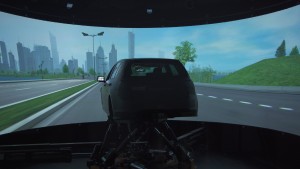SUaaVE: a European-funded project aimed at improving users’ acceptance, trust and comfort regarding future Level 4 Automated Vehicles
The introduction of autonomous vehicles is set to disrupt the automotive industry and market. The transformation of the driver to a passenger requires new systems, new design and new features, both from the technological point of view and the user-centered part. Other aspects such as comfort, security, ethics and design will also need to be considered.
The European project, SUaaVE (SUporting acceptance of automated VEhicle), aims to solve the gap between technological advancement and public acceptance by including the final user in the process of design and prototyping.
“Colouring" CAV's decision-making processes of with human emotions
ALFRED (Automation Level Four+ Reliable Empathic Driver) is a system theorized in the SUaaVE project that aims at “colouring the decision-making processes of the Connected and Automated Vehicles (CAV) with human emotions”. In other words, it aims to be a user-centred technology able to adapt to the user state considering concepts like acceptance, ethics, emotion and comfort.
Thanks to the collaboration between several European professionals, ALFRED will be able to adapt to the emotion, comfort status and ethics issues of users. This will increase people’s acceptance of future automated vehicles.
ALFRED use cases
In recent years, the development of new product or services includes the final users in the process of design and implementation. This involves the study of how the final product will be used in the real world, increasing the possibility that it will be efficiently, safely and enjoyably used.
In order to carry out these studies, at the beginning of a design process, use cases are created. Use cases include the context of use, type of users and possible events (or issues) in the use of a system.
In the automotive industry, the creation of use cases is a necessary step in order to have an idea of how users will use and interact with the system. In the case of SUaaVE, this also makes it possible to predict the acceptance of the new L4 vehicle of the future.
In the SUaaVE project, part of IDIADA’s work was to create these use cases. Four things were included for this: the Operational Design Domain, the context, the types of users and the events happening.
Operation Design Domain
For experts in the automotive sector, ODD is not something new and within the context of automated vehicles (especially L4) this term is widely used. To simplify the definition, an ODD is the context and environment where a vehicle can work autonomously. As a hypothetical example, an L4 vehicle can be designed to be autonomous only on highways with no roadworks and only in daylight. The combination of these characteristics is called ODD.
Users, context, environment and event
Regarding the types of users who will interact with ALFRED, they can be divided into primary and secondary users. The former being the ones directly interacting with the vehicle and the latter being other vehicle drivers, service users and transport management personnel.

Journey context characteristics are defined by the start and finish location, the planned stops, the journey purpose, user’s activity before and after the journey as well as user’s activity during the journey.
The interaction between the vehicle and the environment will affect the user’s experience, emotion, acceptance, trust and comfort. During any given scenario, ALFRED will respond to changes in the operational environment triggering different users’ perception outcomes.
The events happening during the scenario have been developed in order to trigger controlled reaction to the user’s emotional state and perception. More in depth, the events are used to investigate the reaction that users have to certain situations and can be differentiated by generic or usual events occurring during a normal driving situation, or specific events that trigger change in the user’s emotional, psychological and physical status.
New evaluation methodology applied to ALFRED
Much of the work undertaken by IDIADA revolves on the construction of the use cases and the methodology underlying ALFRED’s evaluation. The evaluation framework is based on the testing of ALFRED with a comparison being made with a normal connected automated vehicle (CAV) through multiple phases.
The use cases forming the evaluation framework will provide detailed definitions joined to the end use of the vehicle to provide relatability to the test outcomes. The use cases will be the reference for the construction of scenarios for the evaluation of the acceptance of the vehicle by the users, the emotions triggered by the events, and the ethics implications in the use of the vehicle.
The construction of use cases is the fundamental pillar for the future design and evaluation of the ALFRED system; however, this method can be applied to the development of all future automated vehicle systems. Never before has the user had such a fundamental role in the design and development of new systems. As said above, the introduction of autonomous and automated cars will disrupt the market, but will come with different human factor issues that have to be considered. The use cases and IDIADA’s work in the SUaaVE project aims to mitigate these issues.
With the development of the SUaaVE use cases, IDIADA is laying the foundation for accepted and enjoyable automated vehicles. This experience and expertise can be applied to future projects to increase the successful introduction of connected, automated and adaptive vehicles on the market.